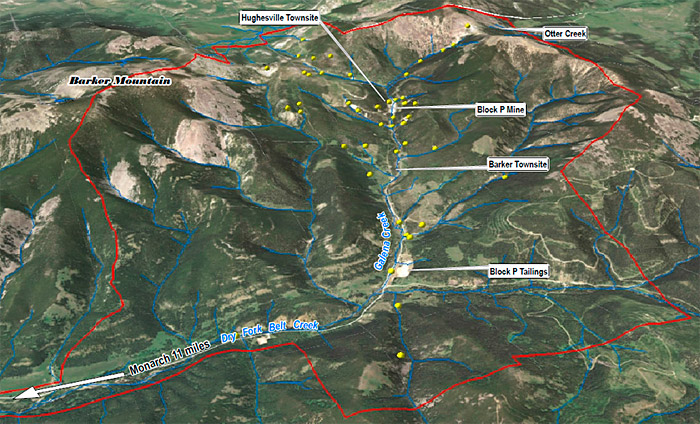11.11 Barker Hughesville Mining District Superfund Site, Cascade/Judith Basin County, Montana
Contact: Lynn Woodbury
Organization: CDM Smith
Email: [email protected]
11.11.1 Site Description and Conceptual Site Model
The Barker Hughesville Mining District Superfund site is in the Little Belt Mountains in west-central Montana, about 40 miles southeast of Great Falls and about 10 to 12 miles east of the town of Monarch.
Detailed information on the site is presented in the Remedial Investigation report (USEPA 2016g). In brief, the site is renowned for its rich mining legacy and prospered through the later part of the 19th and early 20th century. Silver and lead were discovered in the Galena Creek drainage in 1879, and by the next year the area had several hundred claims. Silver and lead mining boomed in the 1880s and 1920s, and continued sporadically into the 1940s. Historical mining camps in Barker and Hughesville, located along Galena Creek, were home to miners who worked at nearby mines and ore processing facilities. A smelter near Barker operated from 1881 to 1883. Mining tapered off around 1883, after the depletion of surficial ore bodies. Operations resumed upon completion of a rail line between the site and the Great Northern Line in Monarch, with periods of increased activity in the 1920s and early 1940s. Large-scale mining in the area ended in 1943 when all operations ceased. This area contains approximately 46 abandoned mines strewn with waste rock dumps, tailings, and seeping mine adits (see Figure 11-12).

Figure 11‑12. Barker-Hughesville Mining District Site location and layout.
Mining operations typically generate several different types of solid waste, including waste rock, mill tailings, and streamside tailings. These mine wastes often are found to contain elevated levels of several different metals. Excess exposures to these metals are known to cause a range of noncancer and cancer effects in humans, so people who live within or visit the site could be at risk of adverse health effects.
11.11.1.1 Source of the Lead
11.11.1.2 Land Use/Exposure Scenarios
11.11.2 Methodology Used for Evaluating Bioavailability
11.11.3 Calculated Bioavailability of Lead in Soils
11.11.4 Application of Bioavailability to Risk Assessment
11.11.5 How Did Bioavailability Results Affect Site Decisions?
11.11.6 Regulatory, Community, and Cost Considerations


